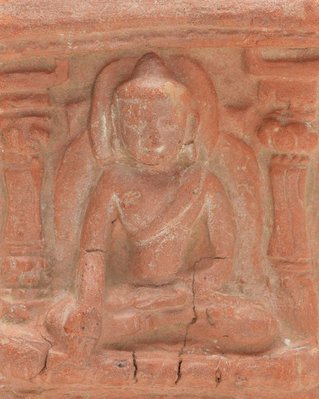-
Details
- Place where the work was made
-
Gansu Province
→
China
- Period
- Tang dynasty 618 - 907 → China
- Date
- 618 CE-907 CE
- Media category
- Ceramic
- Materials used
- red clay, unfired
- Dimensions
- 16.7 x 11.0 x 5.3 cm
- Signature & date
Not signed. Not dated.
- Credit
- Bequest of Eleanor Hinder through her executors 1975
- Location
- Not on display
- Accession number
- 267.1975
- Copyright
- Share
-
-
About
Buddhism reached China about the first century BCE from India where it had developed during the fourth and third centuries BCE. The Chinese received the teachings of the two main schools of Buddhism, Mahayana and Hinayana, although eventually it was Mahayana that dominated the Far East while Hinayana became the stronger influence through Southeast Asia. Buddhism spread slowly through China, along the main routes of internal trade and communication. Buddhism had to be "translated" into terms the Chinese could understand because of the huge cultural gulf between the Indian religion and Chinese thinking. It was not until the end of the Han dynasty (206BCE - 220CE) that Buddhism began to gain influence. During the period after Han when China was divided into North and South, Buddhism strengthened albeit differently as it adapted itself to the two different evolving cultures of north and south. In the north it commended itself to the foreign conquerors because it was an alien, non-Chinese religion; in the south it adjusted to both elite and popular needs. When China again became unified under the Sui (581-618) and Tang (618-906) dynasties, Buddhism was seen as an instrument for unifying north and south and was widely supported by the authorities.
This is an ornamental wall-tile from Gansu Province with moulded relief decoration. A smaller but comparable piece in the Malcolm MacDonald collection is covered with white slip with traces of unfired black and green pigments, indicating that this piece may have been painted also. The figure on the brick is a Buddha as evident by his aureole, the ushnisha and his seated position with hand extended. The Buddha sits within his own ornately decorated niche. The tile no doubt was part of a whole wall comparable in design to known cave paintings of the period.
Jackie Menzies, 'Early Chinese Art', AGNSW, 1983. cat. no. XXVI.
-
Places
Where the work was made
Gansu Province
-
Exhibition history
Shown in 2 exhibitions
Early Chinese art, Art Gallery of New South Wales, Sydney, 26 Feb 1983–08 May 1983
Buddhist Art from the Collection of the Art Gallery of New South Wales, Art Gallery of New South Wales, Sydney, 06 May 1995–10 Sep 1995
-
Bibliography
Referenced in 1 publication
-
Jackie Menzies, Early Chinese Art, Sydney, 1983, not paginated. cat.no. XXVI. See 'Further Information' for text.
-

